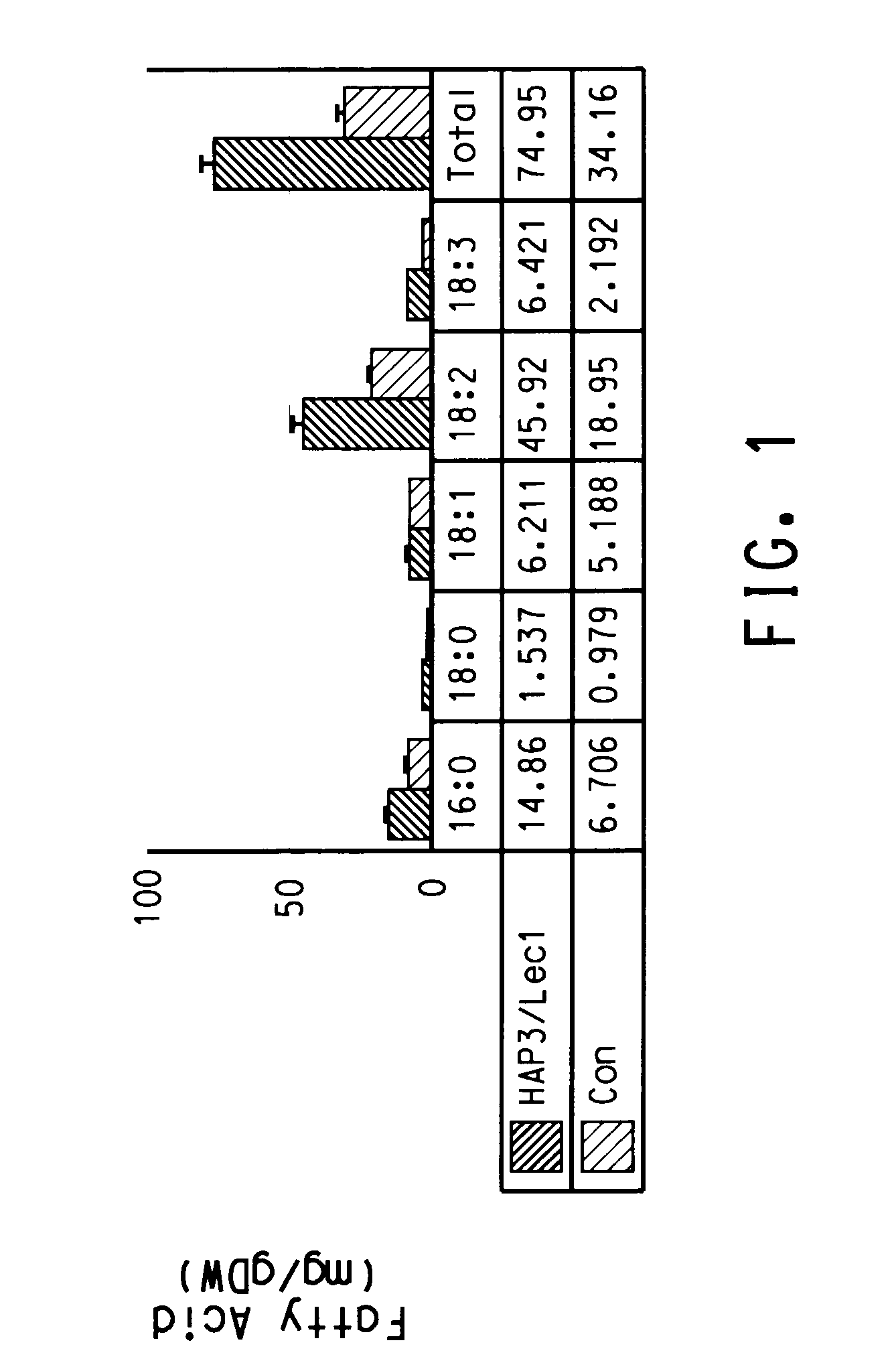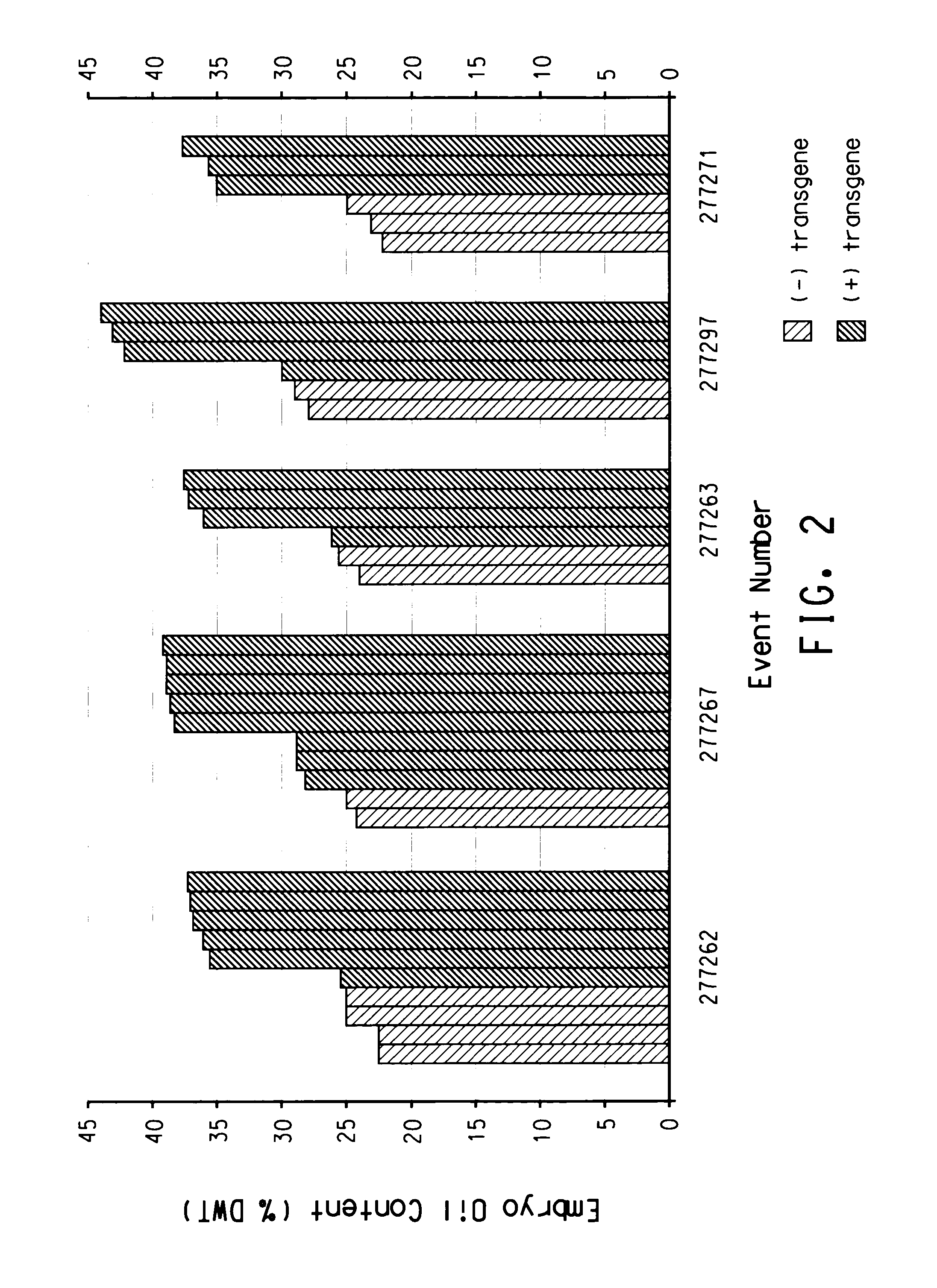Alteration of oil traits in plants
- Summary
- Abstract
- Description
- Claims
- Application Information
AI Technical Summary
Benefits of technology
Problems solved by technology
Method used
Image
Examples
example 1
Composition of cDNA Libraries; Isolation and Sequencing of cDNA Clones
[0226]cDNA libraries representing mRNAs from various plant tissues were prepared. The characteristics of the libraries are described below.
[0227]
TABLE 2cDNA Libraries from Various PlantsLibraryTissueClonecbn 10Corn Developing Kernel (Embryo andcbn10.pk0005.e6:fisEndosperm); 10 Days After Pollinationcbn10.pk0064.e6cc71se-aCorn Callus Type II Tissue, Somatic Embryocc71se-a.pk0002.e11:fisFormedcc71se-bCorn Callus Type II Tissue, Somatic Embryocc71se-b.pk0018.e4:fisFormedccaCorn Callus Type II Tissue, Undifferentiated,cca.pk0026.d6Highly Transformableccase-bCorn Callus Type II Tissue, Somatic Embryoccase-b.pk0003.b9:fisFormed, Highly Transformablecco1nCorn Cob of 67 Day Old Plants Grown incco1n.pk062.j7Green House*cco1n.pk086.d20:fiscco1n.pk0014.d4:fiscco1n.pk055.o18cco1n.pk089.g17cco1n.pk068.f18:fiscde1cCorn (Zea Mays, B73) developing embryocde1c.pk003.o22:fis20 dapcde1nCorn (Zea mays, B73) developing embryocde1n.pk0...
example 2
Identification of cDNA Clones
[0233]cDNA clones encoding proteins involved in altering plant oil traits were identified by gene profiling (see Examples 6 and 8) and by conducting BLAST (Basic Local Alignment Search Tool; Altschul et al (1993) J. Mol. Biol. 215:403–410; see also www.ncbi.nlm.nih.gov / BLAST / ) searches for similarity to sequences contained in the BLAST “nr” database (comprising all non-redundant GenBank CDS translations, sequences derived from the 3-dimensional structure Brookhaven Protein Data Bank, the last major release of the SWISS-PROT protein sequence database, EMBL, and DDBJ databases). The cDNA sequences obtained in Example 1 were analyzed for similarity to all publicly available DNA sequences contained in the “nr” database using the BLASTN algorithm provided by the National Center for Biotechnology Information (NCBI). The DNA sequences were translated in all reading frames and compared for similarity to all publicly available protein sequences contained in the “...
example 3
Characterization of cDNA Clones Encoding Proteins Involved in Altering Oil Phenotypes
[0235]The BLASTX search using the EST sequences from clones listed in Table 3 revealed similarity of the polypeptides encoded by the cDNAs to receptor protein kinases, MEK3 homologs, Hap2 homologs, LIP 15 homologs, calcium EF-hand proteins, ATP citrate lyase, glucose metabolism proteins such as SNF1 homologs, Lec1 transcription factors, and seed developmentally regulated transcription factors such as CKC (Aintegumenta-like) homologs from various species including Arabidopsis thaliana, rice (Oryza sativa), corn (Zea mays), soybean (Glycine max), cucmber (Cucumis sativus), Sordaria (Sordaria macrospora), sesame (Sesamum indicum), grape (Vitis sp.), Brassica (Brassica napus), and tobacco (Nicotiana tabacum). Shown in Table 3 are the BLAST results for individual ESTs (“EST”), the sequences of the entire cDNA inserts comprising the indicated cDNA clones (“FIS”), the sequences of contigs assembled from tw...
PUM
| Property | Measurement | Unit |
|---|---|---|
| Fraction | aaaaa | aaaaa |
| Fraction | aaaaa | aaaaa |
| Fraction | aaaaa | aaaaa |
Abstract
Description
Claims
Application Information
 Login to View More
Login to View More - R&D
- Intellectual Property
- Life Sciences
- Materials
- Tech Scout
- Unparalleled Data Quality
- Higher Quality Content
- 60% Fewer Hallucinations
Browse by: Latest US Patents, China's latest patents, Technical Efficacy Thesaurus, Application Domain, Technology Topic, Popular Technical Reports.
© 2025 PatSnap. All rights reserved.Legal|Privacy policy|Modern Slavery Act Transparency Statement|Sitemap|About US| Contact US: help@patsnap.com


